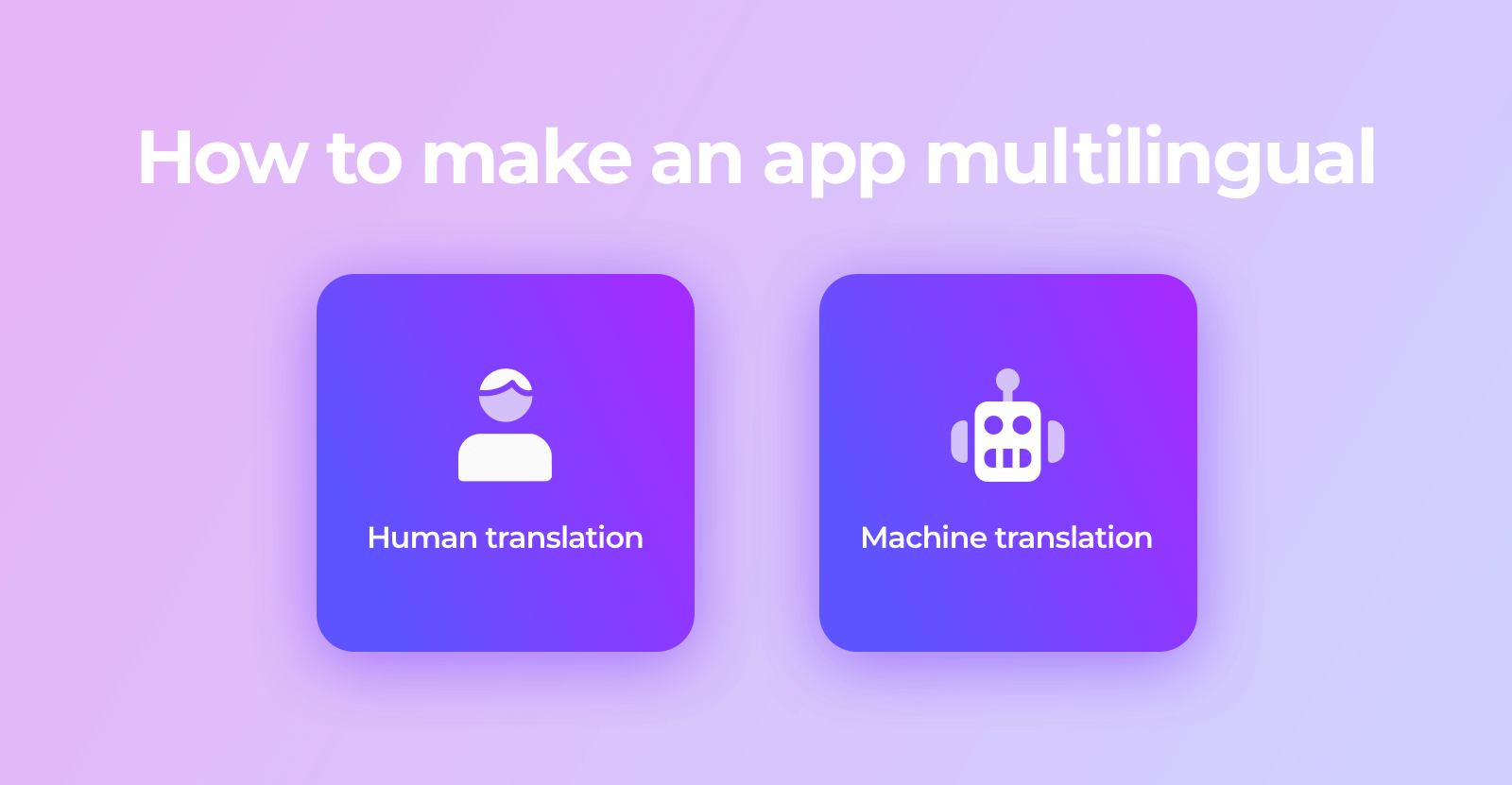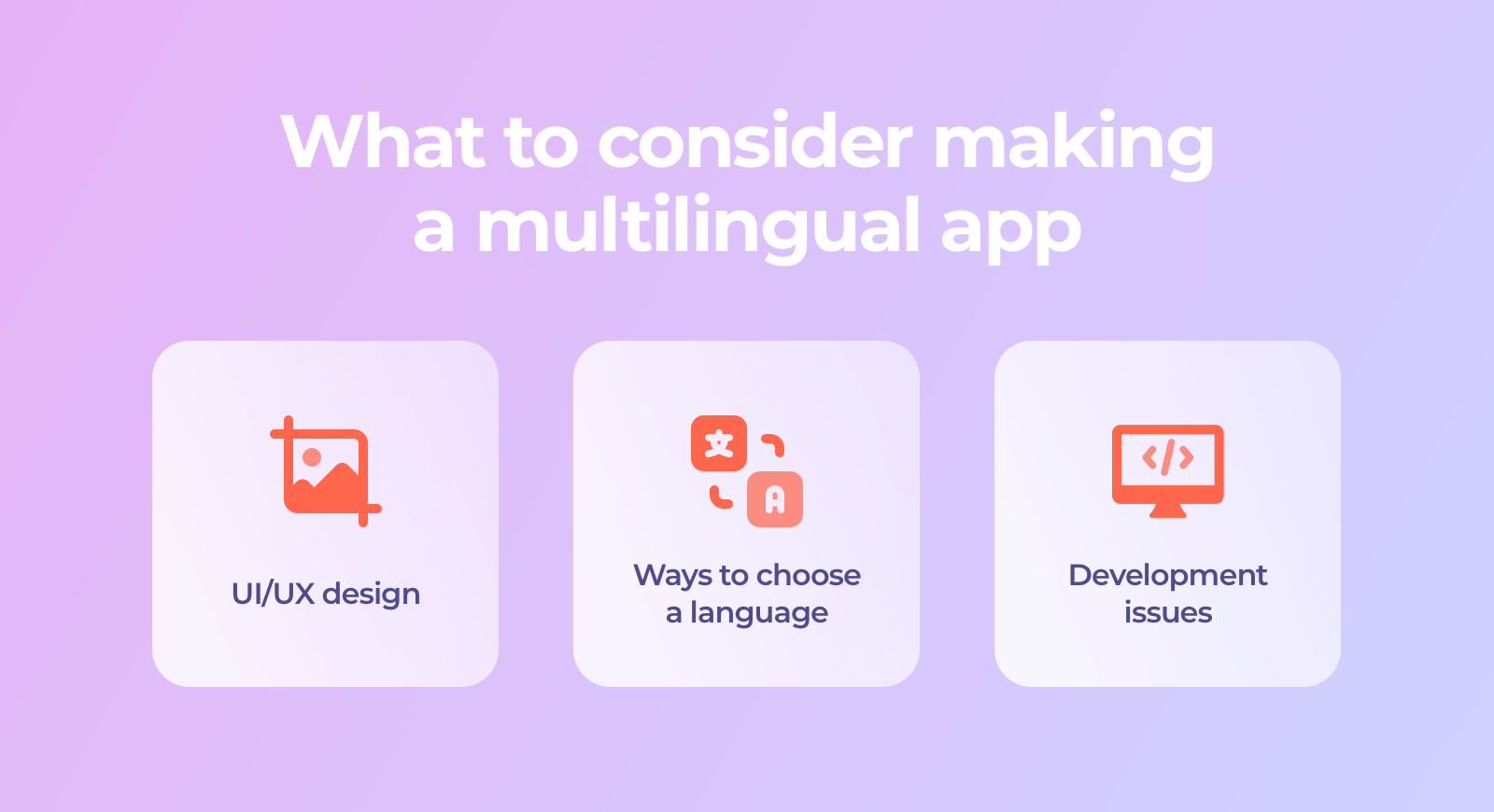What is app localization? Well, some mobile apps become extremely popular in one country but don’t have success in others. Why? There could be a bunch of reasons, from unnecessary content for users to similar solutions on the market. But there’s one thing you can be sure of: if the people in your target market can’t understand your app, it won’t catch on. So app localization is making an app understandable and usable in a target market. It’s important to develop a localized app offering the languages of your target markets.
Localizing the mobile app will make it accessible to the people you want to reach.
Local or Global?
What’s the difference between a local and a global app.
- Local app is an application that satisfies the needs of users in the particular region. It’s common to develop such solutions for local services and businesses. For example, there can be food delivery services from local restaurants.
- Global app is an application that is used in various regions. They offer exciting content for customers from all over the world. For example, social networking sites are targeted worldwide.
Of course, developers and product owners try to decide whether it’s better to create a local or global app. There’s no simple answer.
To help you decide, I’d like to explain when it’s better to start local with some apps and when it’s time to introduce your solution to other regions.
What is App Localization?
So, you want to go global with your outstanding mobile app. One of the main ways to improve the company’s visibility is through language translation. Mind that English is not a simple solution. To engage more customers, you need to add additional languages to reach the local market.
Depending on the type of your business, you’d like to put resources into globalization or localization.
 Why Should You Localize?
Why Should You Localize?
Localization is the adaptation of a website or mobile app for a target foreign market. That includes translating content to fulfill the users’ requirements and expectations.
But, translation isn’t enough. The website must be technically fit for the target market, look good in another language, and be culturally appropriate and adapted to the market.
Localization includes consideration of:
- Number, date, and time formats
- Currency types
- Symbols and icons
- Text and images
- Character encoding
- Line length
- Text orientation (left-to-right vs. right-to-left)
- Name order for personal names (Lina Wang vs. Wang Lina)
The localization process needs a user-friendly design that is attractive to the target market. UI/UX design tends to differ depending on customers’ preferences in various regions.
Learn About App Localization
Visit us on our Localization Services page and fill out the form to discuss what it will take to localize your application.
Visit Localization Services
Why Should You Globalize?
Globalization is also considered as internationalization. It’s the process of making a product and content multilingual.
How does globalization work? You need to develop a product that is easy to localize for any foreign target market.
Such a mobile app or website should be able to:
- Support various languages. Like localization, there is an element of language translation in the globalization process. However, these processes have significant differences. For localization, you should translate the existing content into the language of your target market. For globalization, you translate the content into several languages to make it accessible to various target audiences.
- Have various formats and designs. During the globalization process, you need to pay attention to the design elements for each target market. For example, Western users tend to read from left to right, while some customers from East Asian and Middle East regions read from right to left.
Like the Article?
Click here to share on Twitter>>
Tweet
Click here to follow IVANNOVATION on Twitter and be first to learn about our new content>> Follow @ivannovation
How to Develop a Localized App: Translation Process
There are two typical ways to make your app multilingual — human translation and machine translation — but there’s also a third option . . . Let’s discuss them more precisely.
 Human Translation: Benefits and Drawbacks
Human Translation: Benefits and Drawbacks
From the name, you can say that human translation stands for hiring a translator. There are various options to find such a specialist. For example, you can cooperate with a freelancer or hire a translation agency.
Benefits:
- Human translation provides a high accuracy level.
- Humans tend to translate the meaning, not the words.
- People use creative parts of the language, e.g. puns, metaphors, slogans, etc.
- Humans explain content that can’t be translated literally.
Drawbacks:
- Translation takes a long time.
- Translation can be expensive.
- Working with one translator, you’re limited to the language.
Machine Translation for App Localization: Pros and Cons
Technology allows translating texts faster. Machine Learning and Artificial Intelligence bring companies a bunch of opportunities to translate texts for various industries and fields. However, human translators can’t be replaced, especially for some content types.
Read More
Check out our article—16 Hilarious Machine Translation Mistakes—for examples of why you shouldn’t carelessly make use of machine translation.
There are several reasons someone might choose machine translation.
- Short time-to-market. The first reason is obvious. The machine translates faster. So, it’s good to use software solutions to translate texts. After that, native speakers professionals can edit the text.
- Cost-effectiveness. Let’s face it — a human translation costs more than a machine translation
But there’s a third way to translate apps both accurately AND economically.
Read More
Why Professional Translators Are Needed Despite Machine Translation
5 Reasons To Hire a Developer in Eastern Europe
How to Build a Multilingual App Successfully
PEMT: Another Way
Post-Edited Machine Translation (PEMT) is a hybrid solution of human and machine translation.
The app UI can be translated for free or almost free by machine translation, and then a human professional translator can come to the source and target text and fix any issues with the machine translated target text.
This solution offers speed and savings compared to pure human translation, and it offers accuracy and readability compared to pure machine translation.
This is definitely an option to discuss with your app localization services company.
Translate eLearning Content
Translate structured content for user guides and elearning materials with IVANNOVATION’s DITA XML localization services.
Points to Consider While Building a Localized App
Developing a localized app or website, you need to consider several points in order to create a useful and attractive product.
 I’ve already mentioned the importance of website or app UI/UX design. Creating a solution for another region, you should cooperate with qualified designers. Such specialists consider all the cultural aspects during the app design process. As a result, your website or app will ‘feel’ native to customers.
I’ve already mentioned the importance of website or app UI/UX design. Creating a solution for another region, you should cooperate with qualified designers. Such specialists consider all the cultural aspects during the app design process. As a result, your website or app will ‘feel’ native to customers.
One more significant issue to pay attention to is how users choose the language. There are several ways. Speaking about website design, it’s common to provide a button in the top right corner. You can also ask users to choose the preferred language when they visit the website for the first time.
As for mobile apps, you can also offer to set the language after opening the app. Also, customers should have an opportunity to change the language in the app settings later.
Developing a multilingual app can be a struggle. So, I’d like to highlight several development issues. For example, developers need to deal with different time zones, local places, and more.
To sum up, the multilingual app development requires a lot of preparation. You should consider the content and its translation. It’s better to work with developers and translation professionals who understand the challenges of localization. In this way, you can get better results in the target market.
Like the Article?
Share with all your friends by clicking on a social sharing button below.
About the author: Vitaly Kuprenko is a writer for Cleveroad. It’s a web and mobile app development company with headquarters in Ukraine. He enjoys writing about technology and digital marketing.
Get free localization tips straight to your inbox!
- Get tips on how to translate your website, marketing materials!
- Get actionable advice to help you succeed with localization.
- Be the first to access free language and management tools.




I totally agree that it’s better to work with professionals who understand the challenges of localization. I enjoyed the article and appreciate your research. Thanks for sharing!
Absolutely!
I loved this article on app localization. the way you explained the difference between local and global, why we should localize, and how we can develop such kind of app. is truly very informative. Thanks